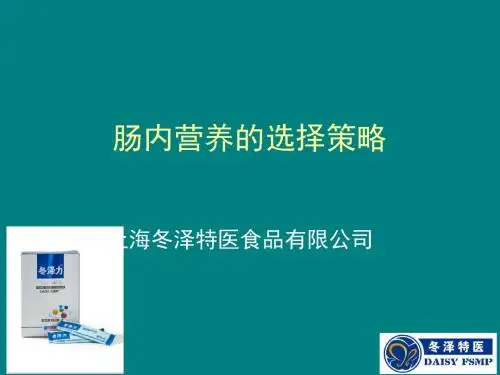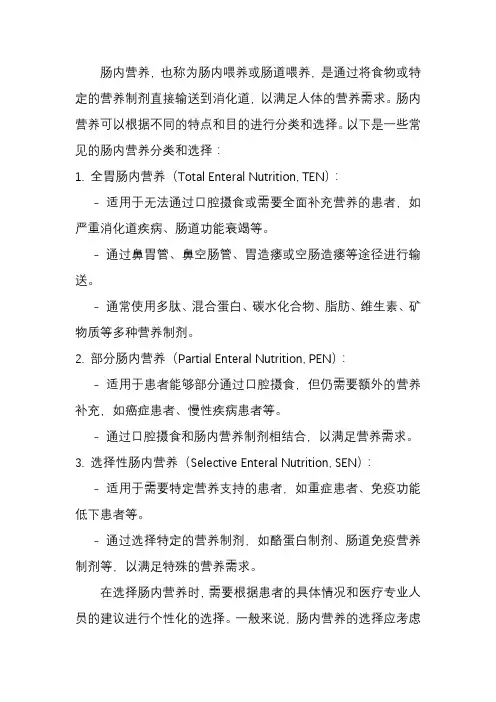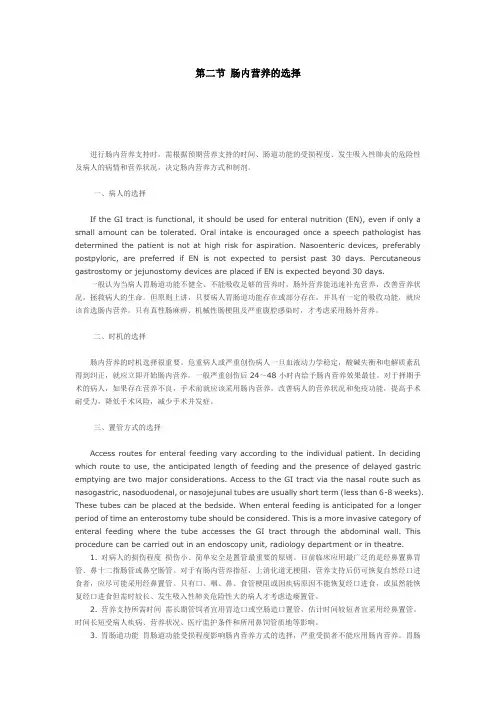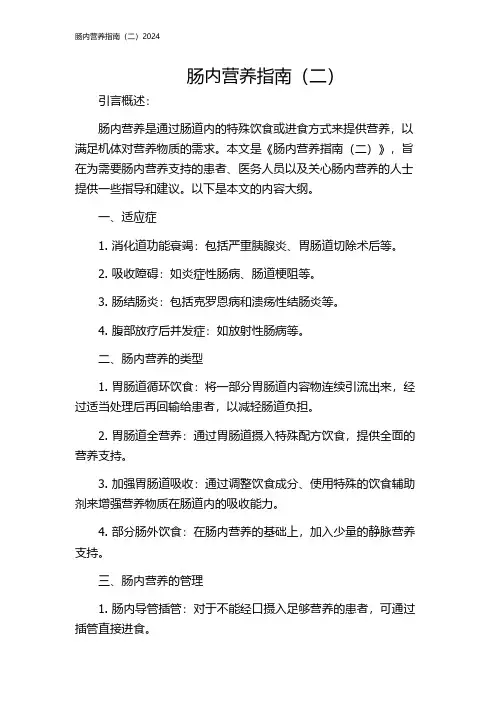第二节-肠内营养的选择
- 格式:doc
- 大小:38.50 KB
- 文档页数:5




肠内营养,也称为肠内喂养或肠道喂养,是通过将食物或特定的营养制剂直接输送到消化道,以满足人体的营养需求。
肠内营养可以根据不同的特点和目的进行分类和选择。
以下是一些常见的肠内营养分类和选择:1. 全胃肠内营养(Total Enteral Nutrition, TEN):- 适用于无法通过口腔摄食或需要全面补充营养的患者,如严重消化道疾病、肠道功能衰竭等。
- 通过鼻胃管、鼻空肠管、胃造瘘或空肠造瘘等途径进行输送。
- 通常使用多肽、混合蛋白、碳水化合物、脂肪、维生素、矿物质等多种营养制剂。
2. 部分肠内营养(Partial Enteral Nutrition, PEN):- 适用于患者能够部分通过口腔摄食,但仍需要额外的营养补充,如癌症患者、慢性疾病患者等。
- 通过口腔摄食和肠内营养制剂相结合,以满足营养需求。
3. 选择性肠内营养(Selective Enteral Nutrition, SEN):- 适用于需要特定营养支持的患者,如重症患者、免疫功能低下患者等。
- 通过选择特定的营养制剂,如酪蛋白制剂、肠道免疫营养制剂等,以满足特殊的营养需求。
在选择肠内营养时,需要根据患者的具体情况和医疗专业人员的建议进行个性化的选择。
一般来说,肠内营养的选择应考虑以下因素:- 营养需求:根据患者的能量需求、蛋白质需求、维生素和矿物质需求等,选择适当的肠内营养制剂。
- 消化功能:根据患者的肠道功能和吸收能力,选择能够被充分吸收的肠内营养制剂。
- 肠道耐受性:根据患者的肠道耐受性,选择合适的肠内营养途径和输送方式。
- 配方特点:考虑肠内营养制剂的成分、比例、浓度等特点,选择符合患者需求的配方。
在使用肠内营养时,需要密切监测患者的营养状况和肠道耐受性,及时调整和调整肠内营养方案。
此外,与医疗专业人员的密切合作和指导也是非常重要的。


第二节肠内营养的选择进行肠内营养支持时,需根据预期营养支持的时间、肠道功能的受损程度、发生吸入性肺炎的危险性及病人的病情和营养状况,决定肠内营养方式和制剂。
一、病人的选择If the GI tract is functional, it should be used for enteral nutrition (EN), even if only a small amount can be tolerated. Oral intake is encouraged once a speech pathologist has determined the patient is not at high risk for aspiration. Nasoenteric devices, preferably postpyloric, are preferred if EN is not expected to persist past 30 days. Percutaneous gastrostomy or jejunostomy devices are placed if EN is expected beyond 30 days.一般认为当病人胃肠道功能不健全、不能吸收足够的营养时,肠外营养能迅速补充营养,改善营养状况,拯救病人的生命。
但原则上讲,只要病人胃肠道功能存在或部分存在,并具有一定的吸收功能,就应该首选肠内营养。
只有真性肠麻痹、机械性肠梗阻及严重腹腔感染时,才考虑采用肠外营养。
二、时机的选择肠内营养的时机选择很重要。
危重病人或严重创伤病人一旦血液动力学稳定,酸碱失衡和电解质紊乱得到纠正,就应立即开始肠内营养。
一般严重创伤后24~48小时内给予肠内营养效果最佳。
对于择期手术的病人,如果存在营养不良,手术前就应该采用肠内营养,改善病人的营养状况和免疫功能,提高手术耐受力,降低手术风险,减少手术并发症。

肠内营养指南(二)引言概述:肠内营养是通过肠道内的特殊饮食或进食方式来提供营养,以满足机体对营养物质的需求。
本文是《肠内营养指南(二)》,旨在为需要肠内营养支持的患者、医务人员以及关心肠内营养的人士提供一些指导和建议。
以下是本文的内容大纲。
一、适应症1. 消化道功能衰竭:包括严重胰腺炎、胃肠道切除术后等。
2. 吸收障碍:如炎症性肠病、肠道梗阻等。
3. 肠结肠炎:包括克罗恩病和溃疡性结肠炎等。
4. 腹部放疗后并发症:如放射性肠病等。
二、肠内营养的类型1. 胃肠道循环饮食:将一部分胃肠道内容物连续引流出来,经过适当处理后再回输给患者,以减轻肠道负担。
2. 胃肠道全营养:通过胃肠道摄入特殊配方饮食,提供全面的营养支持。
3. 加强胃肠道吸收:通过调整饮食成分、使用特殊的饮食辅助剂来增强营养物质在肠道内的吸收能力。
4. 部分肠外饮食:在肠内营养的基础上,加入少量的静脉营养支持。
三、肠内营养的管理1. 肠内导管插管:对于不能经口摄入足够营养的患者,可通过插管直接进食。
2. 肠内营养的饮食管理:选择适宜的肠内营养配方,进行规范的饮食管理。
3. 肠内营养的监测与评估:通过观察患者的体重、营养指标以及肠内导管的情况,进行营养状况的监测和评估。
4. 肠内营养的并发症处理:如导管相关感染、腹痛、腹胀等,并发症的处理和预防。
5. 肠内营养的团队合作:建立由医师、护士、营养师和其他相关专业人员组成的团队,共同管理肠内营养患者。
四、注意事项与禁忌1. 注意营养物质的平衡:根据患者个体差异和具体情况,调整饮食中各营养物质的比例。
2. 禁忌食物:根据患者病情和肠道耐受性,排除对某些食物的摄入。
3. 肠内导管相关并发症的预防:包括导管脱出、皮肤炎症、穿孔等。
4. 肠内营养的适应症与禁忌症:根据患者的具体病情,评估其是否适合接受肠内营养支持。
五、总结肠内营养是一种重要的临床支持手段,能够提供全面的营养支持,促进患者的康复。
在肠内营养的管理中,饮食管理、监测与评估、并发症处理和团队合作都起着重要的作用。

![ICU患者肠内营养的选择[可修改版ppt]](https://uimg.taocdn.com/2534591576a20029bc642d79.webp)


医药界 2020年06月第12期—186—医学教育重症患者的肠内营养,要懂得怎么选择徐 弋(甘孜州人民医院,四川 甘孜 626000)【中图分类号】R 473 【文献标识码】A 【文章编号】2095-4808(2020)12-186-01营养不良是重症患者中较为常见的一种症状,若不满足患者的营养需求,可能会提高患者并发症的发生概率,比如呼吸肌无力、伤口愈合延迟等,进而降低患者的治疗效果,严重时会危害患者的生命健康。
随着现代医学的进步,更多的医疗人员开始注重营养支持治疗的研究。
重症患者的营养支持方向逐渐发生改变,从最初的热量与多种基本要素的补充逐渐变为代谢调理与免疫功能调节。
营养支持是现代危重病治疗的重要组成部分,在对重症患者进行肠内营养支持时,医护人员要掌握更多的专业知识,丰富的经验,结合患者的实际病情对患者进行治疗,由此才能保证患者的生命安全。
一、重症患者肠内营养的选择1.肠内营养的适应症,在临床医学上,肠外营养会增加患者感染并发症的出现,且肠外营养的消费价格更高,安全性与可行性都低于肠内营养。
而肠内营养知识需要患者拥有胃肠道功能,但无法经口安全摄入足够营养的危重患者。
医生在治疗的过程中,要优先考虑肠内营养。
若患者处于血液动力学稳定的状态下,可以进行早期肠内营养,即重症监护病房24~48小时内。
相关数据表明,过早进行肠内营养可能会为患者带来危险,但肠内营养的应用优势较为明显,能有效降低患者的死亡率与感染率,改善患者的营养摄取情况。
在采取肠内营养支持时,建议使用早期过渡式肠内营养,允许患者低热卡摄入,避免过度喂养而带来的危害。
患者处于应激期应确保每日喂养20~25Kcal/kg,并按照患者的情况逐日增量,使患者逐渐适应。
但要注意,若患者属于合并肠梗阻,应避免肠内营养支持。
由于肠内营养会使人体腹腔内的压力增大,进一步影响患者的呼吸循环功能。
在对重症患者进行肠内营养支持,若发现患者出现腹泻/腹胀的情况,应及时停止。
第二节肠内营养的选择进行肠内营养支持时,需根据预期营养支持的时间、肠道功能的受损程度、发生吸入性肺炎的危险性及病人的病情和营养状况,决定肠内营养方式和制剂。
一、病人的选择If the GI tract is functional, it should be used for enteral nutrition (EN), even if only a small amount can be tolerated. Oral intake is encouraged once a speech pathologist has determined the patient is not at high risk for aspiration. Nasoenteric devices, preferably postpyloric, are preferred if EN is not expected to persist past 30 days. Percutaneous gastrostomy or jejunostomy devices are placed if EN is expected beyond 30 days.一般认为当病人胃肠道功能不健全、不能吸收足够的营养时,肠外营养能迅速补充营养,改善营养状况,拯救病人的生命。
但原则上讲,只要病人胃肠道功能存在或部分存在,并具有一定的吸收功能,就应该首选肠内营养。
只有真性肠麻痹、机械性肠梗阻及严重腹腔感染时,才考虑采用肠外营养。
二、时机的选择肠内营养的时机选择很重要。
危重病人或严重创伤病人一旦血液动力学稳定,酸碱失衡和电解质紊乱得到纠正,就应立即开始肠内营养。
一般严重创伤后24~48小时内给予肠内营养效果最佳。
对于择期手术的病人,如果存在营养不良,手术前就应该采用肠内营养,改善病人的营养状况和免疫功能,提高手术耐受力,降低手术风险,减少手术并发症。
三、置管方式的选择Access routes for enteral feeding vary according to the individual patient. In deciding which route to use, the anticipated length of feeding and the presence of delayed gastric emptying are two major considerations. Access to the GI tract via the nasal route such as nasogastric, nasoduodenal, or nasojejunal tubes are usually short term (less than 6-8 weeks). These tubes can be placed at the bedside. When enteral feeding is anticipated for a longer period of time an enterostomy tube should be considered. This is a more invasive category of enteral feeding where the tube accesses the GI tract through the abdominal wall. This procedure can be carried out in an endoscopy unit, radiology department or in theatre.1. 对病人的损伤程度损伤小、简单安全是置管最重要的原则。
目前临床应用最广泛的是经鼻置鼻胃管、鼻十二指肠管或鼻空肠管。
对于有肠内营养指征,上消化道无梗阻,营养支持后仍可恢复自然经口进食者,应尽可能采用经鼻置管。
只有口、咽、鼻、食管梗阻或因疾病原因不能恢复经口进食,或虽然能恢复经口进食但需时较长、发生吸入性肺炎危险性大的病人才考虑造瘘置管。
2. 营养支持所需时间需长期管饲者宜用胃造口或空肠造口置管,估计时间较短者宜采用经鼻置管。
时间长短受病人疾病、营养状况、医疗监护条件和所用鼻饲管质地等影响。
3. 胃肠道功能胃肠道功能受损程度影响肠内营养方式的选择,严重受损者不能应用肠内营养。
胃肠功能差、需持续滴入营养液以及有较大误吸危险者,宜用胃或空肠造口置管。
经腹手术的病人,如营养状况差、手术创伤重,或估计术后发生胰瘘、胆瘘、胃肠吻合口瘘等可能性大者,应在术中作空肠造口置管,用于病人较长时间的营养支持。
四、营养液输注方法的选择1. 营养液输注时间的选择根据病人营养需要及其耐受程度而定。
一般使用间歇输注,病人可以有较大的活动度,适用于胃肠道功能较好的病人。
对于胃肠道功能差、严重营养不良、并发症多、高应激状态或躁动的病人,可以给予连续性输注,一般为连续喂养20小时、间歇4小时,以让消化系统有足够的时间休息。
对于消化、吸收功能非常差或使用抑酸剂的病人甚至可以24小时持续喂养。
The length of time which enteral feeding is given depends on the patient's needs and tolerance as well as local practices. If a patient requires full nutritional support it is usual to feed over about 20h with a 4-h rest period to allow the gastric acidity to return to normal. If the patient is given antacids, the feeding can continue over 24h if required as the gastric acidity is already altered.2. 营养液输注速度的选择病人由肠道旷置到重新耐受肠道内营养物质需要一段时间,因此刚开始输注肠内营养液时应遵循低渗、少量、慢速的原则。
一般间歇性输注病人开始肠内营养时,营养液的滴速宜控制在25~50ml/h。
如病人耐受,可每8小时增加25~50ml,16小时后可增加100ml,24小时可增加150ml左右。
如病人不耐受,滴速增加的幅度应减慢。
连续性泵输注的病人可匀速输注,最初滴速亦为25~50ml/h,每8小时增加25~50ml,最终的平均滴速宜为100ml/h左右,最高可至200ml/h。
调整滴速的依据是胃内潴留物的检查。
If a patient has not been fed in the last 5 days, feedings should begin as low volume, continuous flow feedings in the range of 25 to 50ml/hour. Depending on the patient's tolerance, the rate can be titrated upward by 25ml every 8 to 12 hours. Residual volume in stomach should be monitored every 2 to 4 hours.If the patient is tolerating enteral feeding, the length of time that they are fed can be reduced, and the rate must increase to make sure all requirements are met. In situations where adult patients are well established on feeding, feeds can be administered at a rate of up to 200ml/h by pump or bolus.五、营养制剂的选择胃肠道功能良好者可用管饲滴注含完整蛋白的完全膳食,如匀浆膳、混合奶等,小儿可给予婴儿膳。
如果口咽无梗阻,经一段时间管饲营养支持后病情缓解,可逐渐恢复自然饮食。
但对口、咽、食管有梗阻,或因疾病、手术而吞咽功能受损者,则需长期管饲完全膳食。
消化吸收功能较差者,可以采用要素制剂。
详见下一节。
六、能量、氮量及液体量的选择Since the loss of protein stores directly affects body function, it is important to administer sufficient amounts of energy and protein.1. 能量肠内营养支持的实施首先要确定病人的能量需要量。
In the past, hyperalimentation (the delivery of energy in excess of requirements) was thought to be efficient in improving nutritional status. However, hyperalimentation has been shown to induce severe metabolic abnormalities such as hyperglycemia, hyperlipidemia, andincreased carbon dioxide production. Patients receiving nutritional support should be fed to their requirements.In clinical practice, selected methods for estimating basal energy requirements are shown in Box 9.1.1. A frequently used simple guideline for estimating the daily energy needs of a patient is 25-35 kcal/kg body weight.Box 9.1.1 Selected methods for estimating energy requirementsHarris-Benedict equation (estimates basal energy expenditure)Male:(13.75×W)+(5.0×H)+(6.76×A)+66.47Female:(9.56×W)+(1.85×H)-(4.68×A)+655.1where W is weight in kilograms; H is height in centimeters; A is age in years.To predict total energy expenditure (TEE), add an injury/activity factor of 1.2-1.8 depending on the severity and nature of illness.Ireton-Jones energy expenditure equationsObesityIEE =606S+9W+12A+400V+1444Spontaneously breathing patientsEEEs =629-11A+25W-609OVentilator-dependent patientsEEEv =1925-10A+5W+281S+292T+8518EEE is in kcal/day; subscript V indicates ventilator dependent; subscript S indicates spontaneously breathing.S: sex (male=1, female=0)V: ventilator support (present=1, absent=0)T: diagnosis of trauma (present=1, absent=0)B: diagnosis of burn (present=1, absent=0)O: obesity > 30% above ideal body weight from 1959 Metropolitan Life Insurance tables (present=1, absent=0)In the clinical situation, additional disease-associated factors should be taken into account during the calculation of the required energy needs. These include disease stress factor, activity factor, and temperature factor. Energy and nutrient losses from malabsorption should be taken into account when present.能量的供给并非多多益善,不仅要考虑病人的能量消耗,还要考虑病人的实际代谢能力。